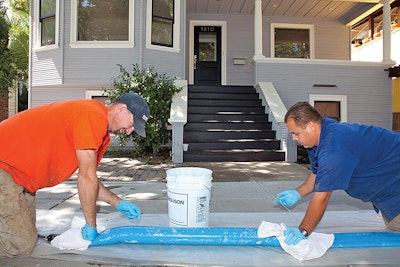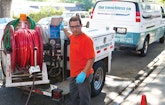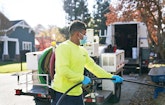
Trenchless Company crew leader Douglas Lagos uses a RIDGID camera system to monitor the progress of a Picote Maxi Miller prepping a residential sewer pipe for relining, while owner Max Greenberg looks on.
Interested in Relining/Rehab?
Get Relining/Rehab articles, news and videos right in your inbox! Sign up now.
Relining/Rehab + Get AlertsThird-generation plumbers often grow up in the family business and patiently wait for their turn at the helm. Max Greenberg made his own way.
He took his chances on some new technology, branching out to start his own business, The Trenchless Company, when he was 22 years old.
Greenberg first entered the family business straight out of high school, preferring to gain his knowledge of the business in the field rather than the college classroom. He started as an apprentice and worked in various roles in the business. A pattern started to emerge that whenever a service call resulted in a water or sewer line replacement or significant repair, Greenberg was assigned to handle the digging and preparation for installations performed by the master plumbers. Eventually he was assigned his own helper and began making these types of repairs and installations himself, leaving the master plumbers to handle emergency calls.
It was this experience in the field that made clear where he wanted to focus his efforts and future. “It was hard work, it was physical, and I just really enjoyed the work. I knew I wasn’t interested in the traditional plumbing repairs like faucets, water heater installs and the like, and I became passionate about this side of the business,” Greenberg says.
He also had a chance to operate a septic pumping truck for about 18 months and this gave him the chance to directly interact with customers, which helped prepare him to take a leadership role in the company. In late 1999, Greenberg approached his father about learning other aspects of the business, in particular the administration and financial elements. As he became more active in this role, expanding his knowledge and exploring new technology, father and son began having difficulties seeing eye-to-eye on the future direction of the company.
Bursting onto the scene
In 1999 while Greenberg was busy learning the management side of the business, he attended the annual WWETT Show (then known as the Pumper & Cleaner Environmental Expo) and encountered a booth that changed the course of his career. “I’ll never forget it; it said ‘Replace Sewer Lines Without Digging,’” says Greenberg. “I was sore from the job that we were on just a day or so ago and thought, ‘Am I reading this right?’ So I had to know how this was possible.”
In that TRIC Tools booth they were showcasing pipe bursting, which was then pioneering technology. He arranged to have a field demo on his next project. Excited about the potential of what this could mean to the business, he rushed to share his findings with his father.
The demo proved that pipe bursting could do everything it claimed, and Greenberg immediately saw the potential new revenue stream for the business. The equipment investment would be $30,000 to $50,000, but using this method could save production time, not to mention big cost savings for their clients. Even so, Greenberg’s father was skeptical about investing in a technology that hardly anyone was familiar with.
Although he laid out a case for expanding the business in this direction, his father would not budge. “So, it finally hit me that this wasn’t really his problem, it was my problem — and if I wanted to do something about it, then I should take the initiative and do something about it,” Greenberg says.
Greenberg took his then brother-in-law up on an offer to assist with a large project in Arizona that could earn him a large chunk of money to put toward starting this new venture, and also to help him in developing the new business. While working in Arizona, on their off hours the two worked on a business plan, logo, a basic website and financed a van which they had wrapped in graphics featuring the new branding.
Shortly after arriving back in Sacramento with the van, a business plan and $14,000 saved up, Greenberg met one of his mentors for coffee to tell him about his concept. As he showed him the van, the mentor’s only question was: “So, what’s stopping you?” Greenberg told him about the equipment, and explained that if he had the financial means, he could get started immediately. His mentor went to his car and returned with checkbook in hand, offering Greenberg a loan, on the condition that he leave immediately for Oakland, purchase the unit and return to show it to him to prove how the funds were used. The agreement was written and signed on a Starbucks napkin and Greenberg set off to acquire his first TRIC pipe bursting unit.
Exceeding expectations
When Greenberg showed up at the factory to get his bursting equipment, TRIC executives agreed to finance a small portion of the initial equipment purchase for Greenberg so that he would have everything needed for a solid launch, but they had some doubts about his chances for success. They had never sold bursting equipment to a contractor that did not have an existing plumbing or related business. But far from defaulting in the first year, Greenberg paid off all his loans and purchased two more bursting equipment sets and had three crews running nonstop.
The firm’s fast-track success was due to a wholesaling business model. Greenberg called residential and commercial plumbers who did not currently do trenchless pipe repairs and asked to be their specialty subcontractor. Greenberg and his team would meet with these contractors, review the technology, and provide training to their staff on how to sell the process to customers. The Trenchless Company would also assist with camera inspection services if their client contractors had no camera systems of their own to assess lines and perform pre- and post-job inspections.
The model worked well for a long time but as trenchless technology became more popular and widely accepted, firms that had previously used The Trenchless Company as a subcontractor shifted to investing in their own equipment to perform repairs in-house. Greenberg knew it was time for The Trenchless Company to start going directly to property owners, so he brought on a marketing manager to solidify the company’s marketing message, branding and strategy for its online communications.
The specialty advantage
Although this change would require more investment in marketing, the firm’s specialization gave it an advantage over other plumbing companies in the region. Specialization meant Greenberg could keep his business lean and use the distinction of being a trenchless repair specialty firm to his advantage. He focused on residential and commercial properties only, forgoing entering the municipal market.
In 2006, not wanting to limit its capabilities to pipe bursting, the company added Vermeer and Ditch Witch directional boring and drilling equipment as well as CIPP from a variety of manufacturers including Pipe Lining Supply. They also invested in a CCTV inspection rig for assessment of 6-inch and larger lines. The Trenchless Company is now capable of offering pipe bursting in 2- up to 15-inch-diameter lines, CIPP lining for 6- to 12-inch pipes and sectional repairs in segments as large as 24 inches in diameter. The addition of Picote scaling, cleaning, rehabilitation and reinstatement tools as well as a Dancutter USA robotic reinstatement cutter have opened more commercial markets for The Trenchless Company such as hospitals, schools, high-rise buildings, shopping centers and commercial centers.
Everything Greenberg has chosen to add to his firm’s arsenal is centered on avoiding the dig. “That’s one of the biggest aspects that really set us apart. Because we’ve been specialists in this now for 20 years, we’ve learned a lot along the way. When we take on a project, we know that a solid project management plan, together with looking at the project from different angles will ensure the best possible outcome. It may mean we have to incorporate multiple technologies to get a project completed, and it is that knowledge and diverse set of solutions we now possess that makes us a valuable asset and partner for our clients in resolving their infrastructure rehabilitation.”
Case in point was a recent project for the Sierra Nevada Brewing Co. The company is genuinely concerned about environmental impact and so had set up a PVC system to handle the run-off from the beer production and keep it away from other equipment. This worked for a while; however, high temperatures and the caustic nature of the run-off were too much for the PVC to handle. The system cracked under the strain and started to leak. Sierra Nevada needed to resolve the situation while keeping their plant as green as possible.
Understanding the chemical composition and temperatures of what would be handled by the PVC system, The Trenchless Company looked for the best solution for Sierra Nevada’s needs and green objectives. They found that a CIPP liner with a special vinyl ester resin would stand up to the challenge. Over the course of three months, and around the plant’s operating schedule, crews lined and then reinstated lateral connections in the PVC system using a remotely operated internal robotic cutter. The new liner was put into place to seal the system, and Sierra Nevada Brewing Co. could again operate leak-free.
Culture of community
The Trenchless Company comprises a group of people who have literally “grown up” together. Many of its employees have been with Greenberg since the beginning days of the venture when he was just 22 years old and they have witnessed each other get married, buy their first homes, have children and become active in their communities. As an owner, he has found that some of the most surprising benefits of starting his own firm and doing it on his own terms is being able to see how the business has touched the lives of the many people who have been part of The Trenchless Company family.
“We have an owner who benchmarks his success on how many of his employees own a home, a car and are able to provide all the best for their children,” says Nick DeGraff, director of marketing and business development. “And this stakeholder model is also extended to the firm’s clients and network of vendors.”
This culture of community makes it possible for The Trenchless Company to recruit and retain talent more successfully than other skilled trades firms in the area. The company has established a platform for entry-level team members to grow into more skilled and higher paying positions such as camera technician, full-time estimator, field sales or field supervisor. They also have a generous employee referral reward program that pays $1,000 a year from the time that both employees — the one who refers and the referred hire — are both employed. Both parties have a vested interest in each other’s success and to Greenberg, this is a small expense to protect his most valuable asset: his team.
“It has been one of the most rewarding things I’ve ever done in my life aside from my marriage and having children,” Greenberg says. “That this little idea I had and started out of my 700-square-foot house and one-car detached garage has not only created an amazing life for me and my family but so many other families.”
One star to five
“It’s not whether you’re right or wrong; it’s the customer’s perception that’s the reality and you have to deal with that.” Max Greenberg, owner and founder of The Trenchless Company, took those wise words of his father’s to heart when he started his own business.
Every firm strives to make sure customers are satisfied and will give them a five-star review, but it’s not always possible. When Greenberg encounters those one-star and other negative reviews on social media platforms, rather than get upset or enter defensive mode, he responds personally to each one with the intent of fact-finding and gathering feedback. “It’s not always the feedback you want but it’s the feedback you need and from it, you can grow, make changes and turn that customer around and make them happy,” Greenberg says.
In his experience, hearing out those upset customers who are just ready and waiting to do battle by simply answering that he and his team are going to make it right, instantly diffuses everything and oftentimes leaves the customer in shock that their issue is going to be resolved that easily. They don’t expect that response. “Some of those first-time upset customers are now the ones who reversed their rating, keep coming back and have become some of our best referral sources.”
This approach to negative reviews has also added to his team’s performance and positive attitude overall since they know if things go wrong in the field, they won’t get in trouble — everyone will work together to turn it around and it will be handled. Pressure is lifted and when they interact with customers, they have the confidence that their firm stands behind their work and that it’s always possible to turn one star into five.










